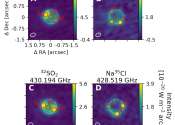US Moon lander 'permanently' asleep after historic landing: Company
An uncrewed American lander that became the first private spaceship on the moon has met its ultimate end after failing to "wake up," the company that built it said.

An uncrewed American lander that became the first private spaceship on the moon has met its ultimate end after failing to "wake up," the company that built it said.
Space Exploration
Mar 25, 2024
0
2959

An international team of astronomers and astrophysicists has confirmed the first known observance of a tidally locked super-Earth exoplanet. In their paper published in The Astrophysical Journal, the group describes the unique ...

Don't be alarmed when the sky goes dark on April 8. A total solar eclipse will traverse North America, crossing Mexico, the United States, and Canada. This event will mark the only total solar eclipse visible from the United ...
Space Exploration
Apr 1, 2024
0
104

China is bolstering its space capabilities and is using its civilian program to mask its military objectives, the head of the US space agency NASA said Wednesday, warning that Washington must remain vigilant.
Space Exploration
Apr 18, 2024
0
65

Three companies are in the running to provide NASA's next moon rover for crewed missions planned later this decade, the space agency said Wednesday.
Space Exploration
Apr 4, 2024
0
111

A total solar eclipse swept across North America yesterday, blocking out the sun momentarily with parts of the continent plunged into darkness. Geostationary satellites orbiting 36,000 km away captured images of the rare ...
Planetary Sciences
Apr 9, 2024
0
24

A pair of underwater researchers at the U.S. Navy's Naval Undersea Warfare Center, working with a colleague from the Advanced Research Projects Agency–Energy, also in the U.S., has found that sounds emanating from coral ...

During the Apollo missions of the 1970s, several seismometers were flown to the moon, where they collected data on lunar seismic trembling for eight years. The data showed some lunar quakes were as powerful as a magnitude ...
Space Exploration
Apr 12, 2024
0
71

Earth was long thought to be the only planet in our solar system with an ocean, but it is beginning to look as though there are underground oceans inside even the most surprising icy bodies.
Astrobiology
Apr 4, 2024
0
50

A team of geologists and planetary scientists from the California Institute of Technology, the University of California Santa Cruz, New York University, and NASA Goddard Space Flight Center reports evidence that Io's volcanic ...
The Moon is Earth's only natural satellite and the fifth largest satellite in the Solar System. The average centre-to-centre distance from the Earth to the Moon is 384,403 km, about thirty times the diameter of the Earth. The common centre of mass of the system (the barycentre) is located about 1,700 km—a quarter the Earth's radius—beneath the surface of the Earth. The Moon makes a complete orbit around the Earth every 27.3 days (the orbital period), and the periodic variations in the geometry of the Earth–Moon–Sun system are responsible for the phases of the moon, which repeat every 29.5 days (the synodic period).
The Moon's diameter is 3,474 km, a little more than a quarter of that of the Earth. Thus, the Moon's surface area is less than a tenth that of the Earth (about a quarter the Earth's land area, approximately as large as Russia, Canada, and the United States combined), and its volume is about 2 percent that of Earth. The pull of gravity at its surface is about 17 percent of that at the Earth's surface.
The Moon is the only celestial body to which humans have traveled and upon which humans have performed a manned landing. While the Soviet Union's Luna program was the first to reach the Moon with unmanned spacecraft, the NASA Apollo program by the United States achieved the only manned missions to date, beginning with the first manned lunar mission by Apollo 8 in 1968, and six manned lunar landings between 1969 and 1972- the first being Apollo 11 in 1969. Human exploration of the Moon temporarily ceased with the conclusion of the Apollo program, although a few robotic landers and orbiters have been sent to the Moon since that time. The U.S. has committed to return to the moon by 2018.
This text uses material from Wikipedia, licensed under CC BY-SA